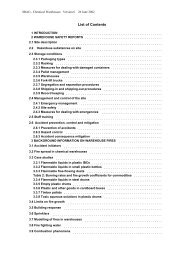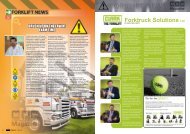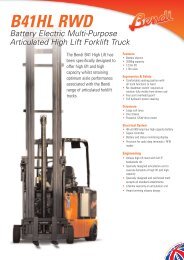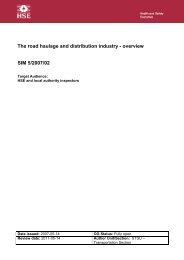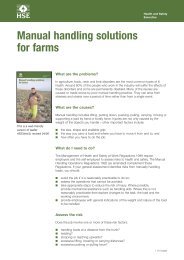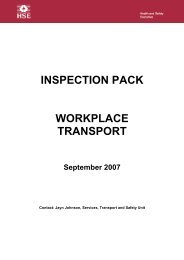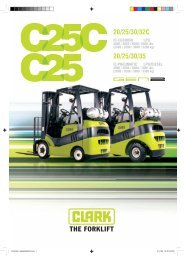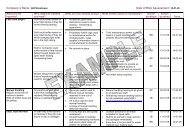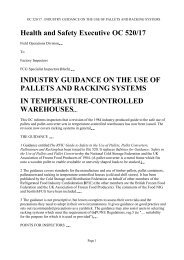Heat stress in the workplace. What you need to know as an employer
Heat stress in the workplace. What you need to know as an employer
Heat stress in the workplace. What you need to know as an employer
You also want an ePaper? Increase the reach of your titles
YUMPU automatically turns print PDFs into web optimized ePapers that Google loves.
●●●work<strong>in</strong>g climate - this <strong>in</strong>cludes air temperature,humidity, air movement <strong>an</strong>d effects of work<strong>in</strong>gnear a heat source;worker cloth<strong>in</strong>g <strong>an</strong>d respira<strong>to</strong>ry protectiveequipment - may impair <strong>the</strong> efficiency of sweat<strong>in</strong>g<strong>an</strong>d o<strong>the</strong>r me<strong>an</strong>s of temperature regulation;worker’s age, build <strong>an</strong>d medical fac<strong>to</strong>rs - mayaffect <strong>an</strong> <strong>in</strong>dividual’s <strong>to</strong>ler<strong>an</strong>ce.Firstly, <strong>you</strong> will <strong>need</strong> <strong>to</strong> talk <strong>to</strong> <strong>the</strong> workers <strong>in</strong>volved(<strong>an</strong>d <strong>the</strong>ir safety representatives), <strong>to</strong> see whe<strong>the</strong>r <strong>the</strong>yare suffer<strong>in</strong>g early signs of heat <strong>stress</strong>. If it seems likelythat <strong>the</strong>re is a problem, <strong>you</strong> may <strong>need</strong> <strong>to</strong> consult withpeople who are more experienced <strong>in</strong> determ<strong>in</strong><strong>in</strong>g <strong>the</strong>risk from hot environments, eg occupational hygienists,nurses or doc<strong>to</strong>rs.How c<strong>an</strong> I reduce <strong>the</strong> risks?Remove or reduce <strong>the</strong> sources of heat where possible:●●●●●●Control <strong>the</strong> temperature us<strong>in</strong>g eng<strong>in</strong>eer<strong>in</strong>gsolutions, eg- ch<strong>an</strong>ge <strong>the</strong> processes,- use f<strong>an</strong>s or air condition<strong>in</strong>g,- use physical barriers that reduce exposure <strong>to</strong>radi<strong>an</strong>t heat.Provide mech<strong>an</strong>ical aids where possible <strong>to</strong>reduce <strong>the</strong> work rate.Regulate <strong>the</strong> length of exposure <strong>to</strong> hotenvironments by:- allow<strong>in</strong>g workers <strong>to</strong> enter only when <strong>the</strong>temperature is below a set level or at coolertimes of <strong>the</strong> day,- issu<strong>in</strong>g permits <strong>to</strong> work that specify how long<strong>you</strong>r workers should work <strong>in</strong> situations where<strong>the</strong>re is a risk,- provid<strong>in</strong>g periodic rest breaks <strong>an</strong>d rest facilities<strong>in</strong> cooler conditions.Prevent dehydration. Work<strong>in</strong>g <strong>in</strong> a hotenvironment causes sweat<strong>in</strong>g which helps keeppeople cool but me<strong>an</strong>s los<strong>in</strong>g vital water that mustbe replaced. Provide cool water <strong>in</strong> <strong>the</strong> <strong>workplace</strong><strong>an</strong>d encourage workers <strong>to</strong> dr<strong>in</strong>k it frequently <strong>in</strong>small amounts before, dur<strong>in</strong>g (this is not possible <strong>in</strong>some situations eg respira<strong>to</strong>ry protective equipmentuse or <strong>as</strong>bes<strong>to</strong>s removal) <strong>an</strong>d after work<strong>in</strong>g.Provide personal protective equipment.Specialised personal protective cloth<strong>in</strong>g isavailable which <strong>in</strong>corporates, for example,personal cool<strong>in</strong>g systems or breathable fabrics.This may help protect workers <strong>in</strong> certa<strong>in</strong> hotenvironments. Protective cloth<strong>in</strong>g or respira<strong>to</strong>ryprotective equipment is often required when <strong>the</strong>rewill be exposure <strong>to</strong> some o<strong>the</strong>r hazard at work eg<strong>as</strong>bes<strong>to</strong>s. This type of equipment, while protect<strong>in</strong>gfrom <strong>the</strong> o<strong>the</strong>r hazard, may <strong>in</strong>cre<strong>as</strong>e <strong>the</strong> risk ofheat <strong>stress</strong>.Provide tra<strong>in</strong><strong>in</strong>g for <strong>you</strong>r workers, especiallynew <strong>an</strong>d <strong>you</strong>ng employees, tell<strong>in</strong>g <strong>the</strong>m about <strong>the</strong>risks of heat <strong>stress</strong> <strong>as</strong>sociated with <strong>the</strong>ir work,what symp<strong>to</strong>ms <strong>to</strong> look out for, safe work<strong>in</strong>gpractices <strong>an</strong>d emergency procedures.●●●Allow workers <strong>to</strong> acclimatise <strong>to</strong> <strong>the</strong>irenvironment <strong>an</strong>d identify which workers areacclimatised/<strong>as</strong>sessed <strong>as</strong> fit <strong>to</strong> work <strong>in</strong> hotconditions.Identify employees who are more susceptible<strong>to</strong> heat <strong>stress</strong> ei<strong>the</strong>r because of <strong>an</strong>illness/condition or medication that mayencourage <strong>the</strong> early onset of heat <strong>stress</strong>, egpregn<strong>an</strong>t women or those with heart conditions.Advice may be <strong>need</strong>ed from <strong>an</strong> occupationalhealth professional or medical practitioner.Moni<strong>to</strong>r <strong>the</strong> health of workers at risk. Where itis considered that a residual risk rema<strong>in</strong>s afterimplement<strong>in</strong>g <strong>as</strong> m<strong>an</strong>y control me<strong>as</strong>ures <strong>as</strong>practicable, <strong>you</strong> may <strong>need</strong> <strong>to</strong> moni<strong>to</strong>r <strong>the</strong> health ofworkers exposed <strong>to</strong> <strong>the</strong> risk. You should <strong>the</strong>n seekadvice from occupational health professionals witha good work<strong>in</strong>g <strong>know</strong>ledge of <strong>the</strong> risks <strong>as</strong>sociatedwith work<strong>in</strong>g <strong>in</strong> heat <strong>stress</strong> situations.Fur<strong>the</strong>r read<strong>in</strong>gNew <strong>an</strong>d expect<strong>an</strong>t mo<strong>the</strong>rs at work: A guide for<strong>employer</strong>s HSG122 (Second edition) HSE Books 2002ISBN 0 7176 2583 4British Occupational Hygiene Society Technical guideNo 12 The <strong>the</strong>rmal environment (Second edition)H <strong>an</strong>d H Scientific Consult<strong>an</strong>ts Ltd 1996ISBN 0 948237 29 5Fur<strong>the</strong>r <strong>in</strong>formationHSE priced <strong>an</strong>d free publications are available by mailorder from HSE Books, PO Box 1999, Sudbury, SuffolkCO10 2WA Tel: 01787 881165 Fax: 01787 313995Website: www.hsebooks.co.uk (HSE priced publicationsare also available from bookshops <strong>an</strong>d free leaflets c<strong>an</strong>be downloaded from HSE’s website: www.hse.gov.uk.)For <strong>in</strong>formation about health <strong>an</strong>d safety r<strong>in</strong>g HSE’sInfol<strong>in</strong>e Tel: 08701 545500 Fax: 02920 859260e-mail: hse<strong>in</strong>formationservices@natbrit.com or write <strong>to</strong>HSE Information Services, Caerphilly Bus<strong>in</strong>ess Park,Caerphilly CF83 3GG.This leaflet conta<strong>in</strong>s notes on good practice which arenot compulsory but which <strong>you</strong> may f<strong>in</strong>d helpful <strong>in</strong>consider<strong>in</strong>g what <strong>you</strong> <strong>need</strong> <strong>to</strong> do.© Crown copyright This publication may be freelyreproduced, except for advertis<strong>in</strong>g, endorsement orcommercial purposes. First published 08/03. Ple<strong>as</strong>eac<strong>know</strong>ledge <strong>the</strong> source <strong>as</strong> HSE.Pr<strong>in</strong>ted <strong>an</strong>d published by <strong>the</strong> Health <strong>an</strong>d Safety Executive GEIS1 08/03 C500



